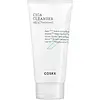What's inside
What's inside
 Key Ingredients
Key Ingredients

 Benefits
Benefits

 Concerns
Concerns

 Ingredients Side-by-side
Ingredients Side-by-side

Water
Skin ConditioningSodium Cocoyl Isethionate
CleansingGlycerin
HumectantGlyceryl Stearate
EmollientStearyl Alcohol
EmollientCoco-Betaine
CleansingSodium Methyl Cocoyl Taurate
CleansingSodium Chloride
MaskingCoco-Glucoside
CleansingCaprylyl Glycol
EmollientGlyceryl Caprylate
EmollientCitric Acid
BufferingEucalyptus Globulus Leaf Oil
PerfumingDisodium EDTA
Ocimum Basilicum Oil
Masking1,2-Hexanediol
Skin ConditioningQuillaja Saponaria Bark Extract
CleansingPropanediol
SolventCentella Asiatica Extract
CleansingCentella Asiatica Leaf Extract
Skin ConditioningCentella Asiatica Root Extract
Skin ConditioningSaccharomyces Ferment
Skin ConditioningEthylhexylglycerin
Skin ConditioningAsiatic Acid
Skin ConditioningAsiaticoside
AntioxidantMadecassic Acid
Skin ConditioningMadecassoside
AntioxidantPinus Pinaster Bark Extract
AntioxidantWater, Sodium Cocoyl Isethionate, Glycerin, Glyceryl Stearate, Stearyl Alcohol, Coco-Betaine, Sodium Methyl Cocoyl Taurate, Sodium Chloride, Coco-Glucoside, Caprylyl Glycol, Glyceryl Caprylate, Citric Acid, Eucalyptus Globulus Leaf Oil, Disodium EDTA, Ocimum Basilicum Oil, 1,2-Hexanediol, Quillaja Saponaria Bark Extract, Propanediol, Centella Asiatica Extract, Centella Asiatica Leaf Extract, Centella Asiatica Root Extract, Saccharomyces Ferment, Ethylhexylglycerin, Asiatic Acid, Asiaticoside, Madecassic Acid, Madecassoside, Pinus Pinaster Bark Extract
Water
Skin ConditioningDisodium Laureth Sulfosuccinate
CleansingCocamidopropyl Betaine
CleansingDecyl Glucoside
CleansingSodium Cocoyl Isethionate
CleansingGlycerin
HumectantPEG-120 Methyl Glucose Dioleate
EmulsifyingAloe Barbadensis Leaf Juice
Skin ConditioningTocopheryl Acetate
AntioxidantPanthenol
Skin ConditioningAllantoin
Skin ConditioningSalix Alba Bark Extract
AstringentCamellia Sinensis Leaf Extract
AntimicrobialSaccharum Officinarum Extract
MoisturisingPyrus Malus Fruit Extract
Skin ConditioningCitrus Limon Fruit Extract
MaskingCitrus Aurantium Dulcis Peel Extract
Emulsion StabilisingCitrus Paradisi Fruit Extract
Skin ConditioningCaprylic/Capric Triglyceride
MaskingPolyquaternium-10
Butylene Glycol
HumectantDimethicone PEG-7 Phosphate
CleansingPhenoxyethanol
PreservativePolysorbate 20
EmulsifyingCaprylyl Glycol
EmollientSorbic Acid
PreservativeWater, Disodium Laureth Sulfosuccinate, Cocamidopropyl Betaine, Decyl Glucoside, Sodium Cocoyl Isethionate, Glycerin, PEG-120 Methyl Glucose Dioleate, Aloe Barbadensis Leaf Juice, Tocopheryl Acetate, Panthenol, Allantoin, Salix Alba Bark Extract, Camellia Sinensis Leaf Extract, Saccharum Officinarum Extract, Pyrus Malus Fruit Extract, Citrus Limon Fruit Extract, Citrus Aurantium Dulcis Peel Extract, Citrus Paradisi Fruit Extract, Caprylic/Capric Triglyceride, Polyquaternium-10, Butylene Glycol, Dimethicone PEG-7 Phosphate, Phenoxyethanol, Polysorbate 20, Caprylyl Glycol, Sorbic Acid
Ingredients Explained
These ingredients are found in both products.
Ingredients higher up in an ingredient list are typically present in a larger amount.
Caprylyl Glycol is a humectant and emollient, meaning it attracts and preserves moisture.
It is a common ingredient in many products, especially those designed to hydrate skin. The primary benefits are retaining moisture, skin softening, and promoting a healthy skin barrier.
Though Caprylyl Glycol is an alcohol derived from fatty acids, it is not the kind that can dry out skin.
This ingredient is also used as a preservative to extend the life of products. It has slight antimicrobial properties.
Learn more about Caprylyl GlycolGlycerin is already naturally found in your skin. It helps moisturize and protect your skin.
A study from 2016 found glycerin to be more effective as a humectant than AHAs and hyaluronic acid.
As a humectant, it helps the skin stay hydrated by pulling moisture to your skin. The low molecular weight of glycerin allows it to pull moisture into the deeper layers of your skin.
Hydrated skin improves your skin barrier; Your skin barrier helps protect against irritants and bacteria.
Glycerin has also been found to have antimicrobial and antiviral properties. Due to these properties, glycerin is often used in wound and burn treatments.
In cosmetics, glycerin is usually derived from plants such as soybean or palm. However, it can also be sourced from animals, such as tallow or animal fat.
This ingredient is organic, colorless, odorless, and non-toxic.
Glycerin is the name for this ingredient in American English. British English uses Glycerol/Glycerine.
Learn more about GlycerinSodium cocoyl isethionate is a natural ingredient from coconut oil. It is an ultra gentle cleanser that gives a nice foam without drying the skin or impacting the skin barrier.
The amount of foam created depends on the amount of sodium cocoyl isethionate used in the product.
This ingredient also helps improve the spreadability of a product.
Learn more about Sodium Cocoyl IsethionateWater. It's the most common cosmetic ingredient of all. You'll usually see it at the top of ingredient lists, meaning that it makes up the largest part of the product.
So why is it so popular? Water most often acts as a solvent - this means that it helps dissolve other ingredients into the formulation.
You'll also recognize water as that liquid we all need to stay alive. If you see this, drink a glass of water. Stay hydrated!
Learn more about Water